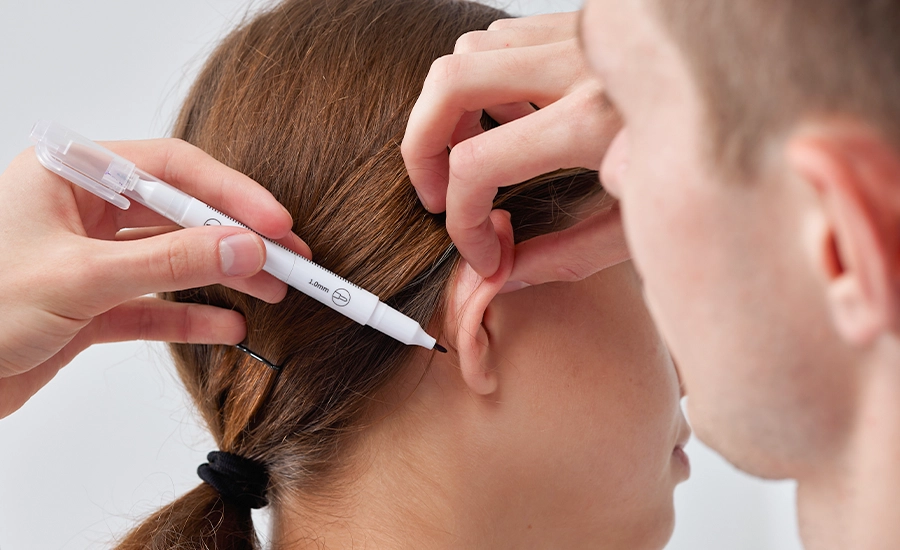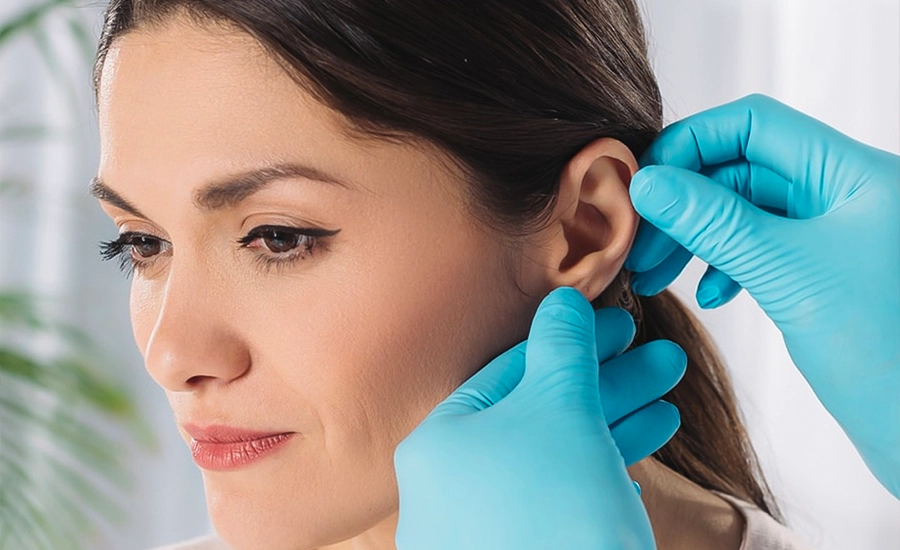Otoplasty: An Introduction
Otoplasty, commonly known as ear surgery or ear correction, is a cosmetic (or sometimes reconstructive) operation to reshape, reposition, or reduce the size of the ears. The main goal is to bring harmony and balance to the face, fix ears that stick out too much, correct asymmetry, or repair deformities caused by birth defects or trauma.
Because the ears sit prominently on the face, even small improvements can yield significant aesthetic and psychological benefits. Many people who feel self-conscious about their ears find that otoplasty greatly boosts their confidence.
In recent years, medical tourism Turkey has grown strongly, and otoplasty in Antalya (and across Turkey) is becoming an increasingly popular choice for international patients seeking high quality at lower costs.
In this post, we’ll explore what otoplasty is, who is a good candidate, how the procedure works, recovery, risks, and finally a cost comparison (with Turkey vs other countries).

Why Choose Otoplasty?
Aesthetic & Psychological Benefits
- Prominent or protruding ears may draw unwanted attention or teasing, especially in childhood or adolescence.
- Correcting ear deformities can improve facial balance and symmetry.
- Many patients report increased self-esteem, more confidence in social settings, and a happier self-image after otoplasty.
Reconstructive & Functional Reasons
- Some patients have congenital ear malformations (e.g. microtia, lop ear, shell ear) that require corrective surgery.
- Traumatic injuries or burns may damage the ear’s structure; otoplasty (or related reconstructive ear surgery) can help restore form.
- In some cases, revisional otoplasty is needed if a previous surgery did not produce satisfactory results.
Who Is a Good Candidate for Otoplasty?
Ideal Candidates
- Individuals (children or adults) with ears that protrude too much or have excessive asymmetry.
- Patients in good health, without conditions that impede healing (e.g. uncontrolled diabetes, bleeding disorders).
- People who have realistic expectations — otoplasty can improve, but not necessarily perfect, ear appearance.
- For children, many surgeons consider performing it after age ~5–6, when the ear cartilage is more developed.
When Otoplasty Might Not Be Suitable
- Patients with ongoing ear infections or chronic skin conditions affecting the ear area.
- Those expecting a “perfect” result or expecting exact symmetry without any natural variance.
- Individuals whose general health precludes safe surgery or anesthesia.
A good pre-operative consultation is essential to evaluate each patient’s ears, skin quality, cartilage strength, and desired outcome.
Techniques & Types of Otoplasty
Otoplasty is not a one-size-fits-all procedure. The method used depends on the patient’s ear anatomy, the degree of correction needed, and surgeon preference/experience. Below are common techniques:
1.Ear pinning (setback otoplasty)
- One of the most frequent techniques.
- The ear is repositioned closer to the head by reshaping or folding the cartilage and securing it with sutures.
- Ideal for ears that protrude outward too much.
2.Cartilage scoring / reshaping / excision
- In some cases, portions of cartilage are removed, carved, or scored to achieve the desired curvature.
- Particularly useful when the ear has excess cartilage or rigidity.
3.Incisionless or minimally invasive otoplasty
- For mild protrusion, techniques using sutures or threading methods, often with minimal incisions, may be used.
Less visible scarring but suited only for milder cases.
4.Ear reduction (macrotia reduction)
- When ears are unusually large, tissue and cartilage are selectively removed to reduce size and refine shape.
5.Ear reconstruction / complex deformity correction / revision otoplasty
- These are more advanced surgeries, where complete reshaping or staged reconstructions are needed.
- Revision cases may correct asymmetries, cartilage relapse, or suboptimal healing from previous surgery.
The surgeon will decide which technique (or combination) best suits your anatomy and goals.
How Otoplasty Is Performed
Preoperative Stage
- Medical history and physical exam.
- Photos and measurements of the ears.
- Discussion of expectations, risks, and the surgical plan.
- Preoperative tests (blood work, ECG, etc.) as needed.
Anesthesia
- Local anesthesia with sedation is common for adults.
- For children or more complex corrections, general anesthesia may be used.
The Procedure
- An incision is typically made behind the ear (in the natural fold) to access the cartilage without visible scars.
- Cartilage is reshaped, repositioned, folded, or in some cases partially removed.
- Sutures (permanent or absorbable) are used to hold the new shape or position.
- Incision is closed with fine stitches, and a protective dressing or wrap is applied.
Surgery typically takes 1 to 2 hours, though more complex or bilateral (both ears) procedures can take longer.
Postoperative & Immediate Care
- A compressive dressing or head wrap is worn right after surgery to protect the shape and reduce swelling.
- Pain and discomfort are usually mild and controlled with medications.
- After one or a few days, the bulky dressing may be replaced by a lighter headband, especially at night, to protect the ears while healing.
Recovery, Aftercare & Timeline
Here’s a rough timeline of what to expect:
| Time Frame | What to Expect / Instructions |
|---|---|
| Day 0–1 | Immediately post-op: protective dressings, monitoring, mild pain, rest. |
| Days 2–7 | Swelling and bruising peak then start to subside; follow surgeon’s instructions about headband, sleeping position, wound care. |
| 1–2 weeks | Many patients can return to non-strenuous work or school; stitches may be removed (if non-absorbable) or assessed. |
| Weeks 3–4 | Swelling continues to reduce; most daily activities allowed (avoiding very aggressive contact sports). |
| Months 2–3 | The new ear shape settles; any residual swelling fades further. |
| 6 months+ | Final results often visible; ears should be stable and natural in position. |
Tips for Best Healing
- Sleep with head elevated; avoid pressure on ears.
- Wear the headband as instructed — often especially at night.
- Avoid strenuous exercise, contact sports, or anything that could bump the ears until surgeon clearance.
- Do not wear heavy glasses or anything that rests on the ears until fully healed.
- Attend all follow-up visits so the surgeon can monitor progress and intervene early if any issue arises.
With proper technique and care, otoplasty scars are almost always hidden behind the ears and fade over time.

Risks & Complications
As with any surgical procedure, otoplasty carries certain risks. Choosing an experienced, board-certified plastic surgeon and following post-op instructions reduces those risks considerably. Possible complications include:
- Infection (rare)
- Hematoma or bleeding
- Asymmetry or slight difference between ears
- Overcorrection or undercorrection
- Cartilage shift or relapse over time
- Skin necrosis or poor healing (rare)
- Sensation changes, numbness (usually temporary)
- Need for revision surgery in rare cases
It is vital to discuss with your surgeon what the strategy would be if a revision becomes necessary.
Otoplasty in Antalya / Why Turkey for Otoplasty?
Advantages of Turkey & Antalya in Medical Tourism
- Lower cost: One of the primary draws is that Turkey offers premium care at much lower cost compared to many Western countries.
- High-quality clinics and surgeons: Many clinics are internationally accredited; surgeons often have training and credentials recognized globally.
- Comprehensive packages: Clinics often offer full packages covering surgery, hospital stay, transfers, accommodation, follow-ups, translation services, etc.
- Short waiting times: Unlike some countries with long waiting lists, clinics in Turkey often schedule quickly.
- Beautiful recovery setting: Antalya offers a scenic, relaxing environment for recovery—sunshine, beaches, and tourism attractions.
- Proximity to Europe / ease of travel: For many patients in Europe or the Middle East, Turkey is relatively close and accessible.
If you search for “otoplasty in Antalya”, you will find clinics offering ear surgery within the region, which may reduce your domestic travel in Turkey. (I did not locate a definitive cost just for Antalya in my research, but it may be slightly lower in less major-urban settings compared to Istanbul.)
Of course, always evaluate clinics carefully — credentials, patient reviews, facility accreditations, safety protocols, and transparent pricing.
Cost Comparison: Turkey vs Other Countries
Below is a comparison table illustrating typical cost ranges for otoplasty in Turkey versus several other countries. The figures are approximate and vary depending on procedure complexity, surgeon reputation, included services, and exchange rates. But generally, Turkey remains more affordable.
| Country / Region | Typical Otoplasty Cost Range* | Notes / Inclusions |
|---|---|---|
| Turkey | USD $1,800 – $4,500 | Many clinics include packages (surgery, hospital, transport, accommodation) (مركز بيمارستان للعلاج في تركيا) |
| United States | USD $5,000 – $8,000+ | Surgeon fee, facility, anesthesia often billed separately (HayatMed Clinic) |
| United Kingdom | £2,500 – £5,000+ | Similar separate cost structure in private practice (HayatMed Clinic) |
| Germany / Western Europe | €3,500 – €6,000+ | Higher surgeon and facility costs |
| India / Asia (select) | USD $1,500 – $4,000 | Some low-cost alternatives exist, though standards vary |
* These are indicative ranges; individual clinics may offer costs outside these ranges.
From this table, one can see that while Turkey’s cost is not always the lowest globally, it is typically much cheaper than in the U.S., UK, or Western Europe, while maintaining high standards.
Tips for Choosing a Clinic & Surgeon
When considering otoplasty in Turkey (or anywhere), here are key tips to make a safe, informed choice:
- Verify credentials: Check the surgeon’s certifications, membership in reputable plastic surgery societies, and hospital accreditation.
- Patient reviews and before/after photos: Look for real patient testimonials and photos over time.
- Transparent pricing & inclusions: Ensure you know what’s included (hospital, anesthesia, aftercare, hotel, transfers).
- Communication & language support: For international patients, good English (or your language) communication is essential.
- Facility standards & safety protocols: International accreditation, hygiene standards, emergency support, and post-op care are critical.
- Follow-up care: Ensure the clinic remains reachable after you return home, and ask about revision policies.
- Travel logistics: Consider proximity to airports, ease of travel, visa requirements, and your ability to stay for necessary days for follow-up.
While low cost is appealing, do not compromise safety or quality. In medical tourism, hidden costs or complications from substandard care may outweigh initial savings.
Summary & Final Thoughts
Otoplasty is a highly effective procedure for reshaping, repositioning, or reducing ears. It offers both cosmetic and psychological benefits, often with minimal scarring and relatively quick recovery.
Turkey, and particularly cities like Antalya, has become a leading destination for medical tourism, offering high-quality otoplasty in Antalya (or elsewhere in Turkey) at significantly lower prices than many Western countries. Patients can often get full packages that include lodging, transfers, surgery, and aftercare.
However, lower cost should never be the only selection criterion. The key is balancing affordability with safety, expertise, credentials, and aftercare.
If you like, I can also prepare a version of this blog post tailored specifically to Antalya clinics with actual examples and contact info. Would you like me to add that?
